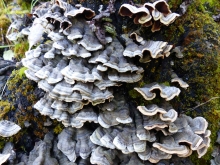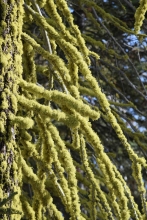Sierra Nevada Fungi
 With a species count that is likely in the thousands, fungi can be found growing in and on a multitude of substrates, including rock, soil, and live and dead trees. Some are involved in symbiotic relationships with other species. One example is mycorrhizae, an association between fungi and plant roots in which the fungus extends the plant root system, increasing water and nutrient absorption. In exchange, the plant provides the fungus with food synthesized in photosynthesis. Another example is lichen, an organism formed by the combination of fungi and either photosynthetic green algae or cyanobacteria. The photosynthetic alga or cyanobacterium lives inside
With a species count that is likely in the thousands, fungi can be found growing in and on a multitude of substrates, including rock, soil, and live and dead trees. Some are involved in symbiotic relationships with other species. One example is mycorrhizae, an association between fungi and plant roots in which the fungus extends the plant root system, increasing water and nutrient absorption. In exchange, the plant provides the fungus with food synthesized in photosynthesis. Another example is lichen, an organism formed by the combination of fungi and either photosynthetic green algae or cyanobacteria. The photosynthetic alga or cyanobacterium lives inside  the fungus and provides it with food. In return, the fungus encloses its partner, providing shade and protection from desiccation. Lichen commonly grow on trees and bare rock. One common species, wolf lichen (Letharia vulpina), is a bright yellow-green fruticose lichen that grows on conifers and resembles a scrubby carpet of moss. Wolf lichen received its name because it was once used to poison wolves and foxes. Today, lichens are studied as biological indicators of air quality. Lichen communities normally vary little from season to season, but community composition will change according to air pollution levels. This is because certain species are more sensitive to pollution than others.
the fungus and provides it with food. In return, the fungus encloses its partner, providing shade and protection from desiccation. Lichen commonly grow on trees and bare rock. One common species, wolf lichen (Letharia vulpina), is a bright yellow-green fruticose lichen that grows on conifers and resembles a scrubby carpet of moss. Wolf lichen received its name because it was once used to poison wolves and foxes. Today, lichens are studied as biological indicators of air quality. Lichen communities normally vary little from season to season, but community composition will change according to air pollution levels. This is because certain species are more sensitive to pollution than others.



